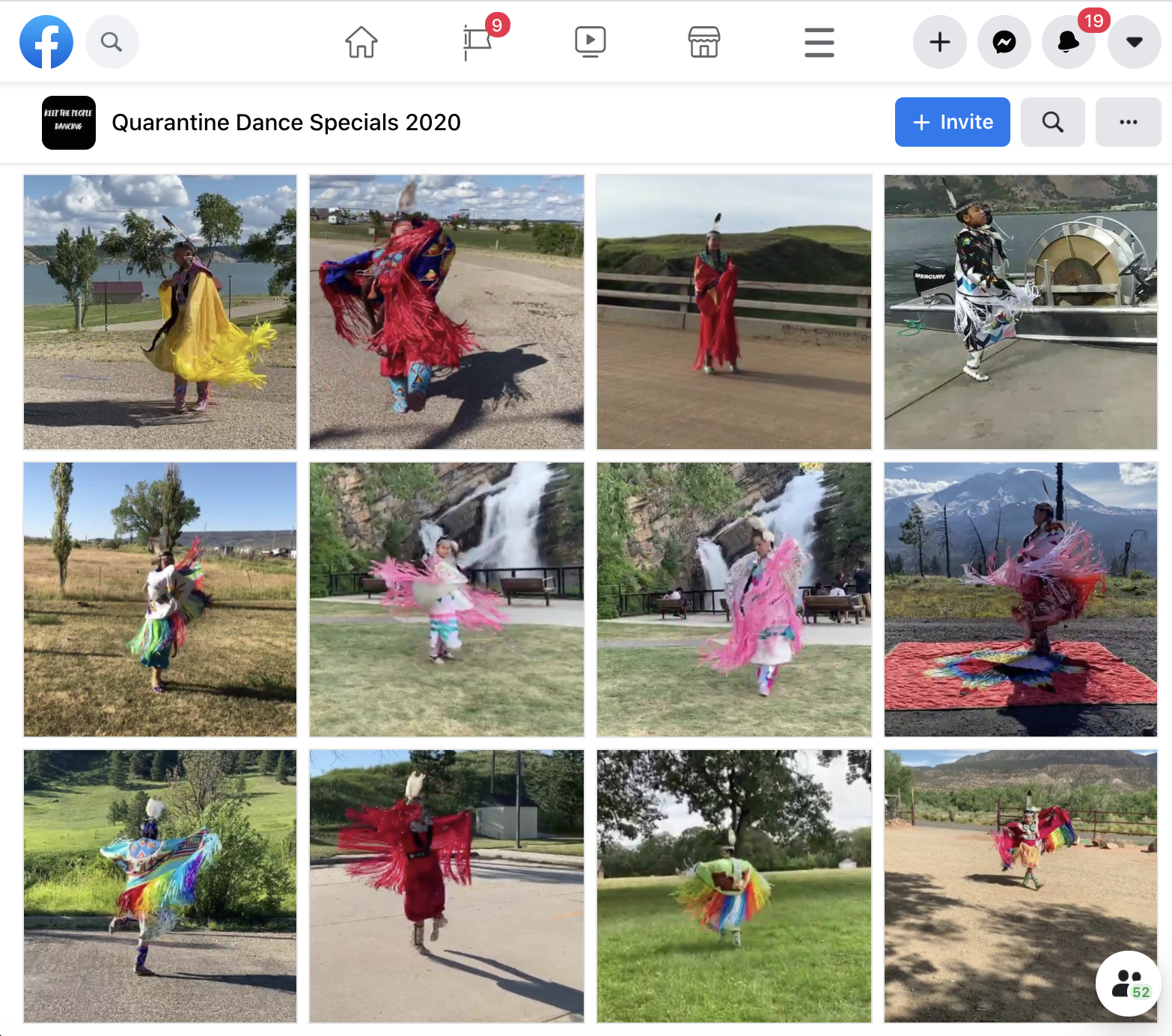
WINNIPEG, Manitoba—Donning her regalia for the first time since January, Pearl Henry (Ojibwe) prepared to participate virtually in the Manito Ahbee Pow Wow’s northern women’s traditional dance special.
“I was excited as I did my hair to get ready,” Henry said. “I seriously felt like I was hurrying to get ready for grand entry. Just like old times.”
“Manito Ahbee has always been one of my favorite powwows, and knowing it was cancelled was really heartbreaking,” Henry said. “It has been very special to me because it’s very close and central and I've always participated in it. I really felt a need to participate in this particular one.”
Instead of joining her dancing sisters at the powwow site in Winnipeg, she took to her front yard to dance alone, with an audience of three: Henry’s daughter recording the dance on her mother’s iPhone, and two more of Henry’s children. There was also an unwelcome contingent of mosquitoes in attendance, Henry said.
From the total serenity Henry exudes in her video, no one would guess she was being assaulted by insects. Wearing a heavily beaded, fringed deer hide shawl and dress, and draped with accessories including a hand-beaded bag, Henry repeatedly bends and extends her legs to the beat.
She submitted the recording just before the deadline. As soon as it showed up on the Quarantine Dance Specials 2020 Facebook group, the comments started flowing in from all over the world, from Honolulu to Aix-en-Provence, France.
“Lovely. So regal.”
“You are absolutely magic.”
“Thank you for showing so much beauty and power.”
“Beautiful beadwork.”
Boozhoo, My name is Pearl Henry from Roseau River Rapids, Manitoba. I am Ojibway and my Anishinaabe name translates to Descending Thunderbird Woman. This is my first time putting my regalia on since January 2020 in Saskatoon. I was excited as I did my hair to get ready. I seriously felt like I was hurrying to get ready for grand entry 😆...just like old times lol Have been just busy to get my video done and I was racing the light of day, battling mosquitoes (ate 2 of them btw🤣) and glitches in my download of our category song. Last minute me🤦🏽♀️...But I feel blessed and happy to dance for you all today. Blessings, happiness and good health to you and all your loved ones. Take care and keep praying for one another. ❤️💕 Sr. woman’s traditional #1200 *****just sharing, my file submission was sent successfully for the Manitoahbee 2020 virtual powwow 😊********* #MAFPowWow2020 #igniteyourspiritPosted by Pearl Henry on Sunday, June 28, 2020
“We dance for healing and wellness, physically, mentally and spiritually,” Henry said. “This Facebook group has helped many dancers and definitely inspired us to keep that powwow spirit alive.”
Since its debut in late March, the Quarantine Dance Specials 2020 group has exploded to 70,000-plus dancers and spectators, and the numbers keep growing everyday.
“I thought I'd get 500, 800, maybe 1,000 members,” said Tiny Rosales (Ojibwe), the group’s creator, who lives in San Jose and is an old-style jingle dancer. “When we were shutting down, I thought, we’ve got to do something. Nobody’s going to be dancing. [People need to] keep dancing no matter what. It's going to pull us through.”
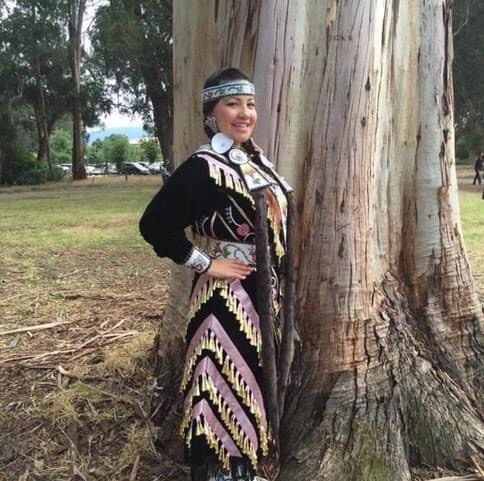 Quarantine Dance Specials 2020 Facebook group founder Tiny Rosales dances old-style jingle. (Photo: Cruz)The phrase “keep the people dancing” is scrawled across the group’s Facebook page, driving home Rosales’s point.
Quarantine Dance Specials 2020 Facebook group founder Tiny Rosales dances old-style jingle. (Photo: Cruz)The phrase “keep the people dancing” is scrawled across the group’s Facebook page, driving home Rosales’s point.
Rosales’s efforts have created a whooping, stomping, swirling, beaded and jingling directory of Indigenous dance.
One minute you can summon a Seneca smoke dancer sweating it out in front of a trailer in New Mexico, then hop over to an Anishinaabe hoop dancer in Vancouver turning and twisting in what appears to be a driveway, and follow that up by clicking on a Shoshone/Chippewa chicken dancer flaunting his feathers in an Oregon forest.
“We are dancing in places that we have never danced in before or would have. Mother Earth thanks you,” one group member wrote to Rosales.
“I cried,” Rosales said. “That will stick with me forever.”
The group features some stand-alone videos of dancers, but it mostly broadcasts “specials”: multi-round dance competitions in selected categories, hosted by a family or organization. The sponsor host supplies cash prizes for the winner and whatever subsequent places are offered. And because the competitions are virtual, every special the Facebook group has held can still be watched online.
Rosales said the group has broadcast more than 100 specials since March and given out about $50,000 in cash prizes supplied by host families and organizations, including the American Indian Cultural Center and Native People Count California, which works to get Native Americans to participate in the census.
Her idea to hold specials in a virtual space took shape when it was announced that the Turtle Mountain Chippewa Pembina Labor Day Powwow in Belcourt, N.D. was cancelled because of the pandemic.
This year, Rosales’s son Arley, who dances in the woodland style, was supposed to have his coming out at the Belcourt powwow. As is custom, her son would have been initiated into the powwow dance circle with a formal ceremony, giving him the right to dance in his selected style. Rosales had chosen woodland dancer and Welch, Minn. resident Cole RedHorse Taylor (Dakota) to introduce Arley.
“You're introducing them publicly to the powwow arena,” Taylor said. “It shows respect to the dancers that have come before you.”
To give Arley and the other dancers the opportunity to dance despite the cancellation, Rosales decided to hold a virtual woodland dance special on her own Facebook page, and came up with the concept of Facebook “Likes” as a way to count positive votes.
The online dance experiment attracted 15 dancers and received a lot of encouraging feedback, she said. Rosales then planned to throw a jingle dance special on her page. After the success of the two specials and the outpour of support, she decided to make a separate page dedicated to dance specials.
Rosales contacted the American Indian Cultural Center, which was supportive of the initiative and agreed to sponsor the group’s debut special.
“We had the jingle special and there were over 100 dancers. We had so many entries we did seven places,” Rosales said. “The next was the grass special, and we kept going from there.”
Dancing in the dark
“My name is Lizzie Pyawasit, I am from Zoar, Wis. on the Menominee Reservation. I am Menominee, Potowatomi, Ojibway and I am Bear clan.”
Hello my name is Lizzie Pyawasit, I am from Zoar,Wi on the Menominee Reservation. I am Menominee, Potowatomi, Ojibway and I am Bear clan. I would like to say Maec Waewaenen to the Sauk n Fox committee for sponsoring this special along with the awesome song! Definitely felt the beat n my feet! Couldn’t have came at a better time and surely brightened my day!❤️ #SaukquarantineWomen
Posted by Lizzie Pyawasit on Thursday, July 9, 2020
Filmed at night, Pyawasit’s dance video is accompanied by an introduction. The only light breaking through the darkness shines on her like a spotlight, like she’s alone on stage, glistening in a satiny green shirt. Long, layered necklaces of bone, shell and beads fly from her chest and click in time to the catchy woodland scrub song.
Pyawasit didn’t intend to dance in the dark. But by the time she was done getting ready, and when her brother and sister-in-law, who had driven her to her parents’ house, were all set up to record, night had fallen.
“We turned the headlights on, and it started sprinkling. I thought, just go with it: that’s as woodland as we can get, in the rain, in the dark out here with the mosquitoes, in my parents’ backyard,” she said. “It was a last minute spur of the moment thing. I literally posted the video right at the deadline.”
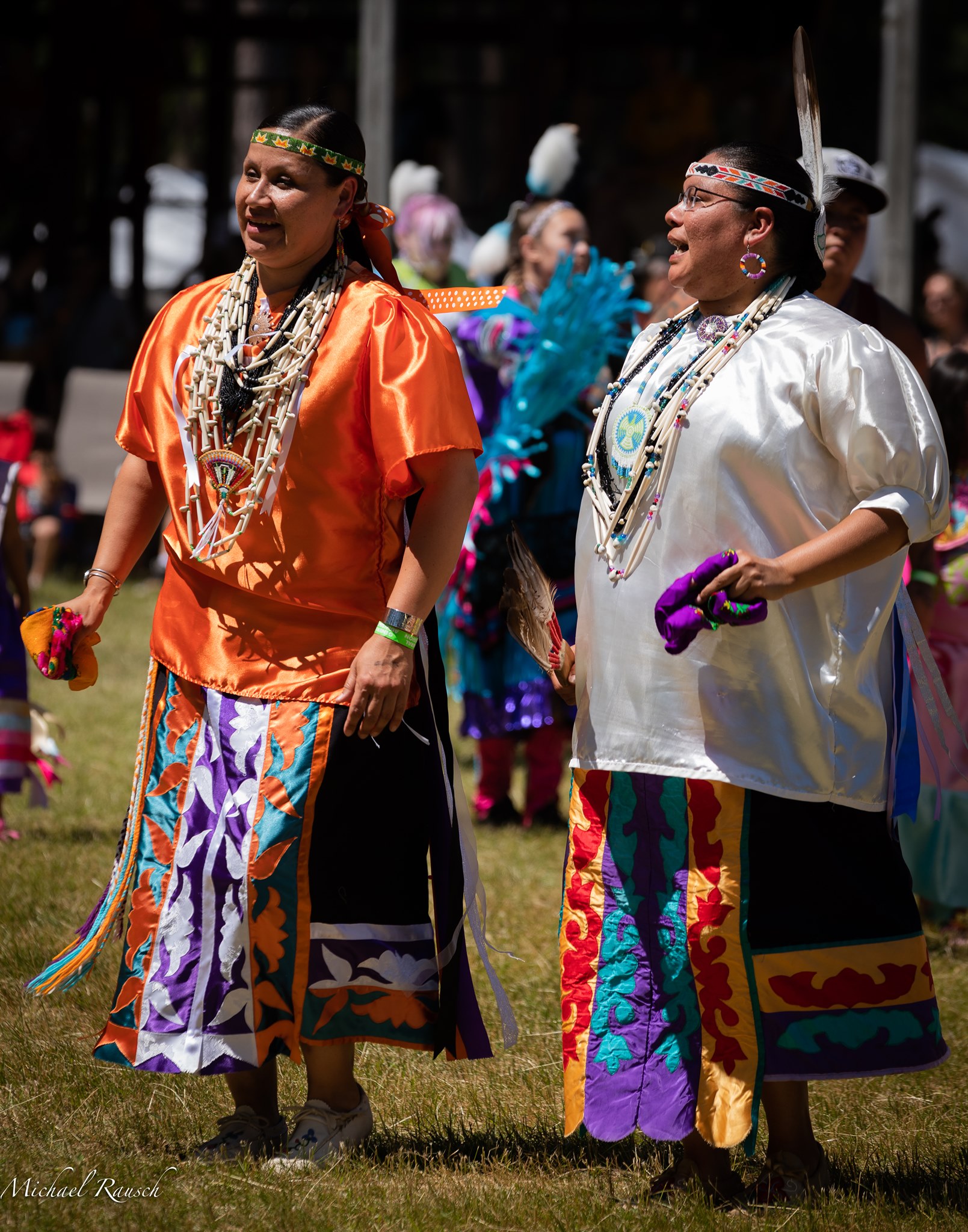 Woodland dancer Lizzie Pyawasit (left) and Jamie Awonohopay in 2019 at The Bear River Pow Wow in Lac du Flambeau, Wisc. Pyawasit's dancing can be seen on Quarantine Dance Specials 2020 Facebook. (Photo: Mike Rausch)If this were a typical year on the powwow trail, Pyawasit would be at the Bear River Pow-Wow in her mother’s hometown of Lac Du Flambeau, Wis.
Woodland dancer Lizzie Pyawasit (left) and Jamie Awonohopay in 2019 at The Bear River Pow Wow in Lac du Flambeau, Wisc. Pyawasit's dancing can be seen on Quarantine Dance Specials 2020 Facebook. (Photo: Mike Rausch)If this were a typical year on the powwow trail, Pyawasit would be at the Bear River Pow-Wow in her mother’s hometown of Lac Du Flambeau, Wis.
“Everybody’s missing the powwow scene and the trail,” said Pyawasit. “We always travelled to powwows and I was always dancing. It’s something I was born and raised with.”
Taking the initiative to get out and dance on her own helped push Pyawasit out of a deep funk. She and her partner recently separated, and she needed a pleasant distraction.
What ultimately inspired Pyawasit –– who’s the first to admit she’s shy –– to post her video was the woodland scrub song Sauk and Fox, the sponsors of the special, selected for her category. Her cousin sent her the song, and Pyawasit was hooked.
“I heard that song and thought, ‘Oh my God I love it. Man, I’m just going to do it,’” Pyawasit said. “It was good to see this special. I watched all the other ladies from Kansas and Canada, and just all over, and it was interesting to see how they portrayed their style with that same song. There are different woodland dances and different types of Indians that consider themselves woodland. It’s not just us.”
Pyawasit said the five-step pattern and shuffling moves she used in her woodland dance, as well as the occasional whooping, recall how her Powotatomi grandmother interpreted the style.
“She said when you whoop it scares away all the bad things. I wasn’t there when she danced. I just heard all the stories,” Pyawasit said. “My grandma would say go out there and dance hard. Dance with your heart. You make people feel good when you dance.”
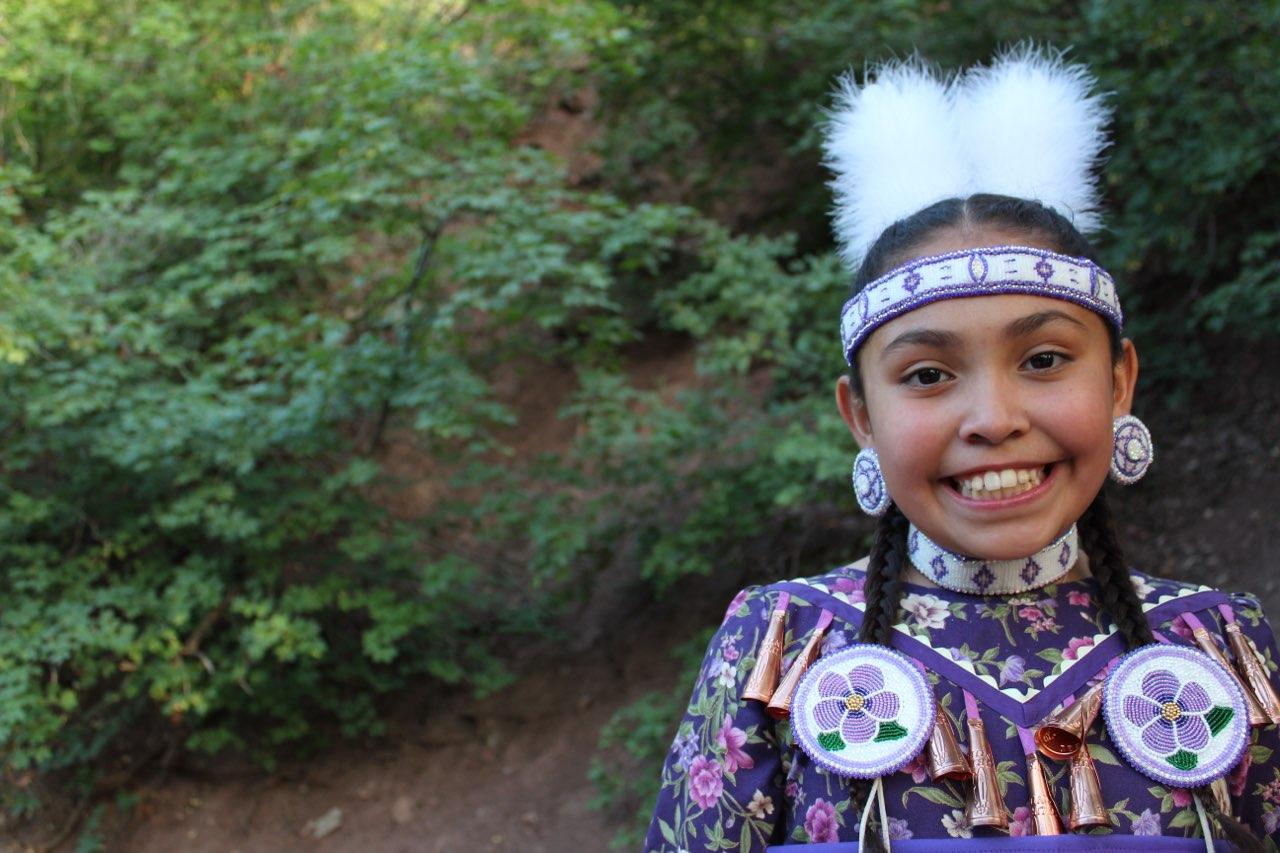 Dancing has been therapeutic for 10-year old Amirrah Renteria, according to her mother. Renteria danced at Suicide Rock in Salt Lake City, Utah. A video of her dancing at the site can be seen on the Quarantine Dance Specials 2020 Facebook group page. (Photo: Deja Chee)
Dancing has been therapeutic for 10-year old Amirrah Renteria, according to her mother. Renteria danced at Suicide Rock in Salt Lake City, Utah. A video of her dancing at the site can be seen on the Quarantine Dance Specials 2020 Facebook group page. (Photo: Deja Chee)
Jingle therapy
“Yá'át'ééh (hello), my name is Amirrah Renteria and I am Navajo and live in Salt Lake City, Utah with my family. I enjoy going to school and, in the summer, going to powwows and meeting new people. What inspires me is learning my traditions from mentors and especially from my grandma who lives on the Navajo Reservation.”
Yá'át'ééh (hello) my name is Amirriah Renteria and I am Navajo and love in Salt Lake City, UT with my family. I enjoy going to school and in the summer going to powwows and meeting new people. What inspires me is learning my traditions from mentors and especially from my grandma who lives on the Navajo Reservation. Most we'd like to thank EllaMichele (Emi) Many Grey Horses-Violich and family for this special and happy birthday! Also thank you to Young Spirit for letting me use a song and approving my request. #ManyGreyHorsesViolichSpecial
Posted by Sharon Memories on Thursday, June 25, 2020
The Quarantine Dance Specials bring out dancers of all ages, like Renteria.
Participants take their dances to empty streets, parks, backyards and landmarks, and anywhere they’re free to dance without the fear of catching COVID-19.
For her daughter’s jingle dance video, Sharon Chee chose Suicide Rock, a popular scenic spot near Salt Lake City.
“The story behind it is a long time ago when Native Americans populated the eastern side of Salt Lake City, a young Native American woman and her partner were fighting in a battle and her partner got killed,” Chee explained. “She didn’t want to be alone, so she ended up jumping from that rock.”
Renteria transformed that sorrowful, yet undeniably beautiful, site into a natural dance floor. Her waving feathered fan catches the sunlight as she hops and steps in a dress dangling with dozens of cone-shaped tobacco lids. The video radiates an empowering sense of freedom and release.
Chee said dancing is therapeutic for Renteria, who had been suffering from anxiety brought on by the pandemic, a series of Utah earthquakes that started in March, and mass powwow cancellations.
“I felt kind of sad because we couldn't go to other states and I couldn’t see my friends,” said Renteria, who is half Navajo and half Mexican-American. Her eight-year-old brother Sebastian is also a dancer, and his grass dancing has appeared on Quarantine Dance Specials as well. The siblings started learning to dance about a year ago.
Now, Renteria uses Quarantine Dance Specials 2020, and other virtual Native American gathering places like Social Distance Powwow, another Facebook group with more than 200,000 members, to shake off her tension, and to learn and get inspiration from other dancers. Renteria’s first dance video was recorded in early April and posted on Social Distance Powwow.
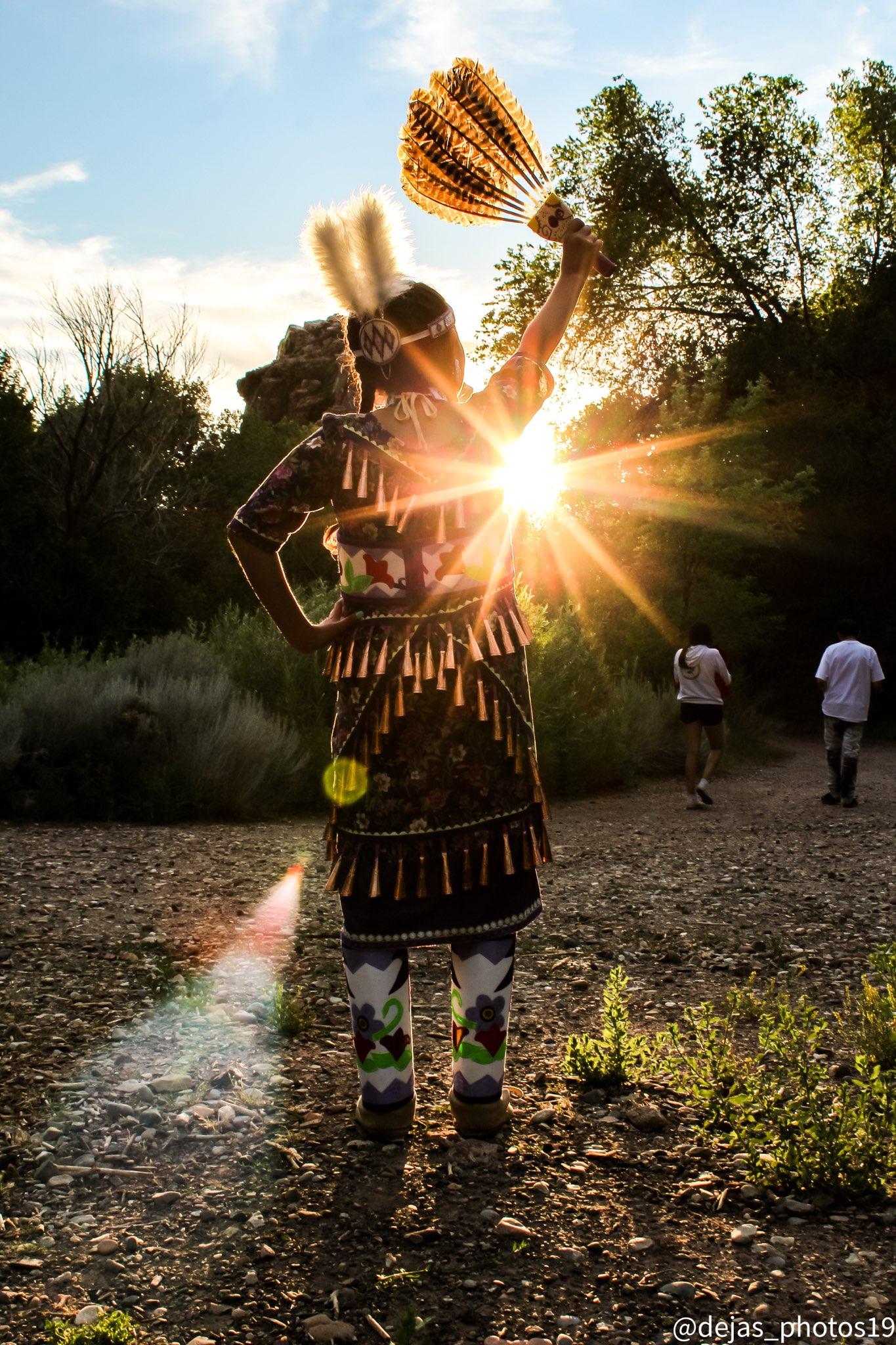 Amirrah Renteria jingle dances at Suicide Rock in Salt Lake City. (Photo: Deja Chee)“Sometimes when I watch my videos over again, I feel like I can do better,” she said. “I am still learning how to do jingle and fancy dance. Our powwow family is trying to teach me.”
Amirrah Renteria jingle dances at Suicide Rock in Salt Lake City. (Photo: Deja Chee)“Sometimes when I watch my videos over again, I feel like I can do better,” she said. “I am still learning how to do jingle and fancy dance. Our powwow family is trying to teach me.”
Renteria added that she enjoys the dance pages because they give a wide audience a glimpse of powwow culture, and she believes dancing is a form of medicine that can help heal everyone during this hard time. And from the effusive comments under her videos, it’s clear that Renteria is spreading her love of dance.
“Beautiful with the sunlight in the background, adding light to your already bright spirit. Miigwetch from Ontario,” one person wrote.
Another added: “Your regalia is amazing! And your dance is too! Many blessings for you and your family! Thank you for sharing!”
Renteria’s inherited floral jingle dress belonged to a dancing cousin, and was gifted to her by an aunt in Taos, N.M.
“It makes her aunt feel good that those dresses can still be danced, and that makes me so happy,” Chee said. “She held on to those dresses for so long.”
The Canadian connection
To wind down for the night, some folks curl up in front of Netflix. Ojibwe dancer Henry kicks back with Quarantine Dance Specials.
“That’s pretty much my evening,” Henry said. “When I'm getting ready for bed, I’ll just turn on the Quarantine Dance Specials page and browse through all the videos, and like them, comment positive things, words of encouragement, and of course, gratitude for sharing.”
While lounging in her Manitoba home, Henry comes across dance styles uncommon in Canada.
“There are different types of dances in the south and north. With this page you can see it all. If we had a powwow here in Canada, we would only see a certain style of dance,” she said. “There are only a few southern dancers that come up this way. Online, we get to see the women’s and men’s southern, and southern men’s fancy.”
The dance Henry posted of herself was the northern women's traditional style.
“It’s done differently, depending on where you come from, or what tribe. My style is stationary. I dance in one spot and don’t move around much,” said Henry, who also performs contemporary jingle dancing. “It looks like it’s easy to do, but our regalia probably has the most amount of beads and the biggest pieces of beadwork, so it’s pretty heavy.”
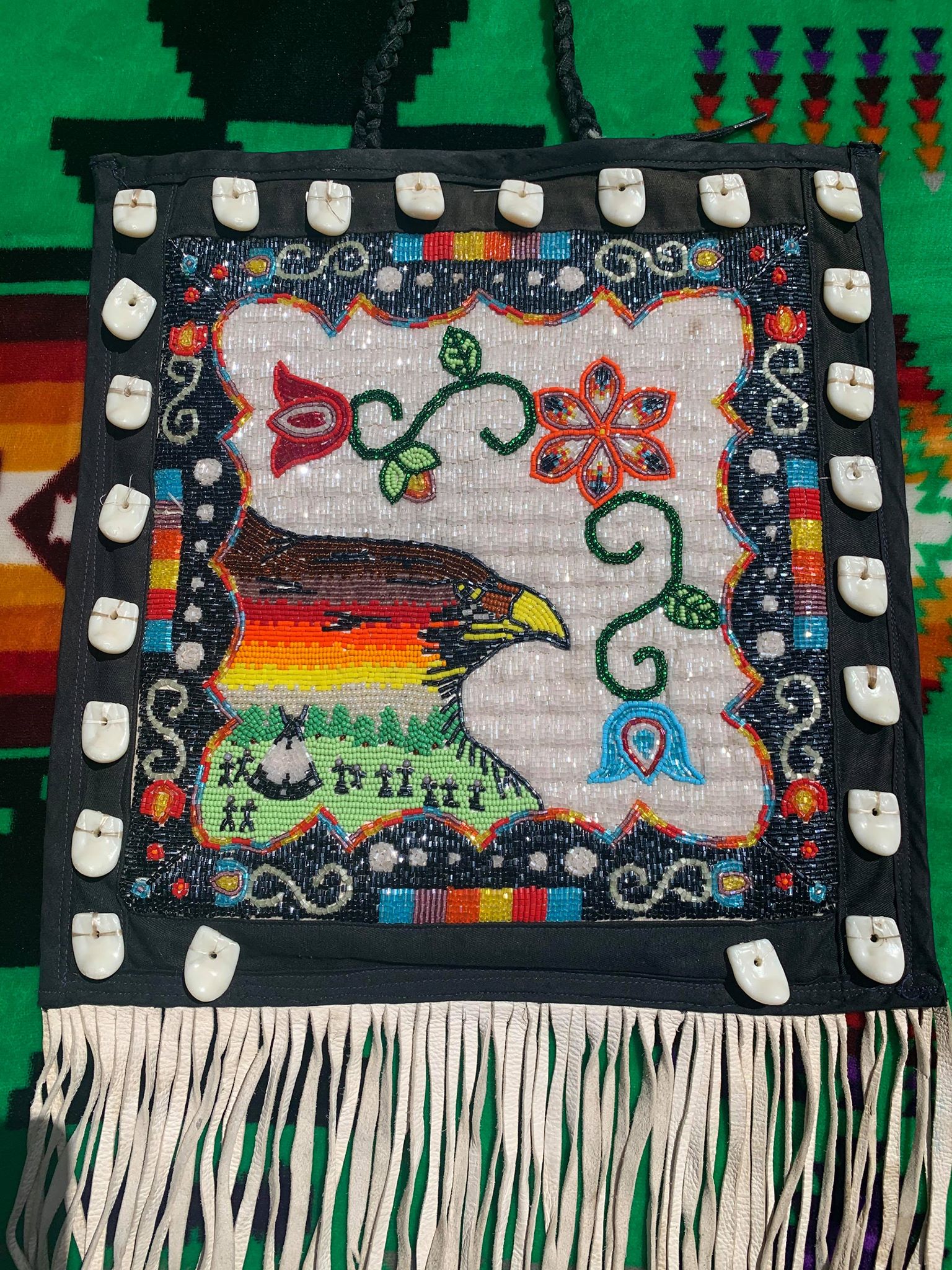 Pearl Henry's dance regalia includes this purse she beaded herself. The designs represent the Ojibwe, her family and The Eagle Clan. Henry’s regalia is replete with detailed floral designs she made herself, and are representative of the Ojibwe people.
Pearl Henry's dance regalia includes this purse she beaded herself. The designs represent the Ojibwe, her family and The Eagle Clan. Henry’s regalia is replete with detailed floral designs she made herself, and are representative of the Ojibwe people.
“Some of the flowers look like flowers, but they have hidden pictures in them,” she said. “I have a baby sitting in a flower. I have the world on a flower.”
Of all the regalia she wears in her dance video, Henry is proudest of the purse she beaded to celebrate her family and her Golden Eagle clan. It depicts a sunset in eagle form, a teepee representing her home and images of her family members.
One of the relatives brought to life through beading is Henry’s mother Marlene Henry. Marlene and Maryann Patrick, a close family friend, taught Henry how to dance. They passed on the little details that personalize a performance, like the way a dancer works their fringe.
“Some will have it really swaying. What I do is kind of flick them,” Henry said. “That's the way I was taught.”
She’s grateful that Rosales’s vision spawned an expansive virtual community of Native dancers who can also express themselves and their traditions in a manner that adapts to the world’s current circumstances.
“Our culture of song and dance will continue to be seen even in quarantine times thanks to social media,” Henry said. “Our people are resilient and we stood together in many trials and tribulations and this is one small example of that.”
More Stories Like This
Zuni Youth Enrichment Project Takes Top Emerging Artist Apprentices to Phoenix for Artistic Exploration and Cultural ImmersionFrom Dishwasher to Award-Winning Chef: Laguna Pueblo's Josh Aragon Serves Up Albuquerque's Best Green Chile Stew
Rob Reiner's Final Work as Producer Appears to Address MMIP Crisis
Vision Maker Media Honors MacDonald Siblings With 2025 Frank Blythe Award
First Tribally Owned Gallery in Tulsa Debuts ‘Mvskokvlke: Road of Strength’
Help us defend tribal sovereignty.
At Native News Online, our mission is rooted in telling the stories that strengthen sovereignty and uplift Indigenous voices — not just at year’s end, but every single day.
Because of your generosity last year, we were able to keep our reporters on the ground in tribal communities, at national gatherings and in the halls of Congress — covering the issues that matter most to Indian Country: sovereignty, culture, education, health and economic opportunity.
That support sustained us through a tough year in 2025. Now, as we look to the year ahead, we need your help right now to ensure warrior journalism remains strong — reporting that defends tribal sovereignty, amplifies Native truth, and holds power accountable.
 The stakes couldn't be higher. Your support keeps Native voices heard, Native stories told and Native sovereignty defended.
The stakes couldn't be higher. Your support keeps Native voices heard, Native stories told and Native sovereignty defended.
Stand with Warrior Journalism today.
Levi Rickert (Potawatomi), Editor & Publisher

